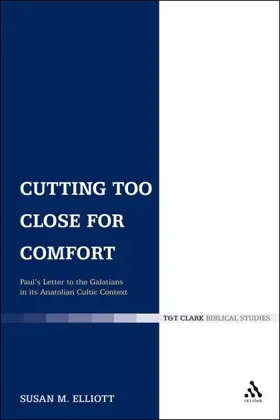

Cutting Too Close for Comfort: Paul's Letter to the Galatians in its Anatolian Cultic Context
in Library of New Testament Studies
Pages
412
Publisher
T&T Clark
Published
1/1/2004
ISBN-13
9780826466600
In Cutting Too Close for Comfort, Susan Elliot considers Paul's letter to the Galatians in its Anatolian cultic context. What does circumcision have to do with castration? Self-castrated devotees of the Mother of the Gods travelled in the central Anatolian territory where the audience of Paul's letter to the Galatians lived. The goddess was identified with many of the region's mountains. In a goddess-possessed frenzy, these galli castrated themselves and became lifetime cultic representatives as her slaves.
Cutting Too Close For Comfort offers a thick description of this cult and other aspects of the Anatolian cultic context to provide solutions to several persistent puzzles in the letter. Starting with problems in the so-called "Hagar and Sarah" passage (4.21-5.1), Elliot argues that Paul attempts to dissuade his audience from being circumcised by identifying circumcision with the enslaving self-castration of the galli and by portraying the Law as a Mountain Mother. The Anatolian background is also seen in Paul's Flesh-Spirit dichotomy in Gal. 3.1-5 and in the Two Ways form in Galatians 5-6.
Cutting Too Close For Comfort offers a thick description of this cult and other aspects of the Anatolian cultic context to provide solutions to several persistent puzzles in the letter. Starting with problems in the so-called "Hagar and Sarah" passage (4.21-5.1), Elliot argues that Paul attempts to dissuade his audience from being circumcised by identifying circumcision with the enslaving self-castration of the galli and by portraying the Law as a Mountain Mother. The Anatolian background is also seen in Paul's Flesh-Spirit dichotomy in Gal. 3.1-5 and in the Two Ways form in Galatians 5-6.
- Contents
- Introduction - Everyone But The Audience
- Part 1: Galatian Problems
- 1. The Law as a Slave-Concubine Mountain
- 2. The Law as an Enslaving Figure: Galatians 3.19-4.11
- Part 2: The Central Anatolian Religious Context
- 3. A Divine Judicial System
- 4. Our Mother, Our Place
- 5. Attis and the Mother
- 6. The Galli: The Mother's Slaves
- Part 3: Paul Persuades His Anatolian Audience to Oppose Circumcision
- 7. The Rhetorical Situation Revisited: Circumcision and Castration
- 8. Hagar, The Meter Sinaiene: Galatians 4.21-5.1 as a Triple Analogy
- 9. The Two Ways and the Unity of Galatians
- 10. Flesh and Spirit in Galatians 3.1-5
- Epilogue